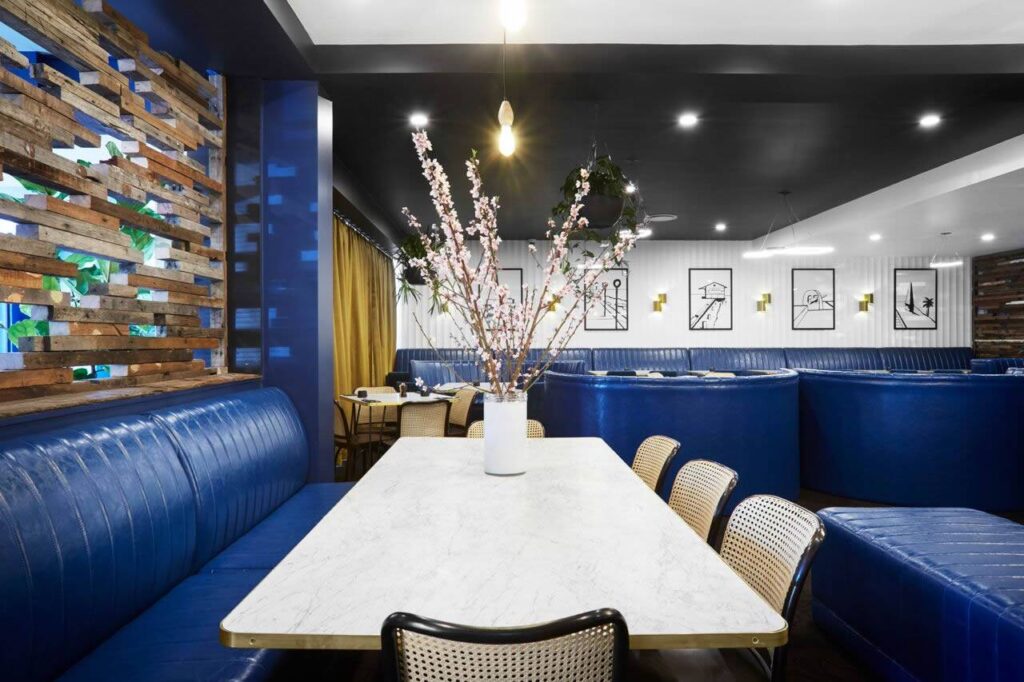In the dynamic world of restaurant design, restaurant booths have become a staple for creating inviting, comfortable, and aesthetically pleasing dining environments. Offering a blend of privacy, style, and functionality, booths are a favorite among restaurant owners and patrons alike. This comprehensive guide explores the advantages, types, design considerations, and maintenance tips for restaurant booths, ensuring they remain a timeless addition to any dining space.
1. Why Choose Restaurant Booths?
A. Enhanced Comfort
Booths provide diners with a comfortable seating experience, thanks to their cushioned seats and backrests. The enclosed design offers a cozy, intimate space, allowing guests to relax and enjoy their meals.
B. Space Efficiency
Booths can optimize the use of space in a restaurant. They accommodate more guests within a smaller footprint compared to traditional table and chair setups, making them ideal for maximizing seating capacity without compromising on comfort.
C. Increased Privacy
With high backrests and enclosed seating areas, booths offer a level of privacy that is difficult to achieve with open table arrangements. This makes them particularly appealing for families, couples, and business meetings.
D. Aesthetic Appeal
Restaurant booths add a touch of sophistication and elegance to any dining space. They are available in various styles, materials, and colors, allowing restaurant owners to customize their appearance to match the overall decor.
2. Types of Restaurant Booths
A. Single Booths
Single booths are designed for placement against a wall, offering seating on one side. These are perfect for smaller restaurants or areas where space is limited.
B. Double Booths
Double booths feature seating on both sides of a shared backrest, typically placed in the center of a dining area. This design is excellent for maximizing seating capacity and facilitating efficient use of space.
C. Wall Bench Booths
Wall bench booths run along the length of a wall, providing continuous seating. They are ideal for large groups and can be customized in length to fit the specific dimensions of a restaurant.
D. Circular Booths
Circular booths offer a unique and stylish seating arrangement. They can accommodate larger groups and create a focal point within the dining area, enhancing the overall ambiance.
E. Custom Booths
Custom booths are tailored to meet the specific needs and design preferences of a restaurant. From unique shapes to personalized upholstery and finishes, custom booths offer endless possibilities for creating a distinctive dining experience.
3. Design Considerations for Restaurant Booths
A. Material Selection
The choice of materials plays a crucial role in the durability and appearance of restaurant booths. Common materials include:
- Upholstery: Leather, vinyl, and fabric are popular choices. Leather and vinyl are durable, easy to clean, and provide a sleek look, while fabric offers a softer, more inviting feel.
- Wood: Wooden frames add warmth and a traditional touch to the booths. Different wood types and finishes can be selected to match the restaurant’s theme.
- Metal: Metal accents or frames provide a modern, industrial aesthetic and are highly durable.
B. Color and Pattern
The color and pattern of the booth upholstery can significantly impact the restaurant’s ambiance. Bold colors and patterns can create a lively atmosphere, while neutral tones promote a calm and elegant environment.
C. Booth Height and Dimensions
Proper booth height and dimensions are essential for ensuring comfort and functionality. The backrest height should provide adequate support and privacy, while seat dimensions must allow for comfortable seating without feeling cramped.
D. Layout and Arrangement
The layout of booths within the restaurant should facilitate smooth traffic flow, easy access for staff, and a pleasant dining experience for guests. Considerations such as aisle width, proximity to other seating, and accessibility are crucial.
4. Maintenance Tips for Restaurant Booths
A. Regular Cleaning
- Upholstery: For leather and vinyl, wipe down with a damp cloth and mild soap to remove spills and stains. Fabric booths may require vacuuming and occasional professional cleaning to maintain their appearance.
- Wooden Frames: Dust regularly and clean with a damp cloth. Avoid harsh chemicals that can damage the finish.
B. Addressing Wear and Tear
Regularly inspect booths for signs of wear, such as loose seams, sagging cushions, or damaged frames. Addressing these issues promptly helps prolong the life of the booths.
C. Protective Measures
Using protective treatments such as stain-resistant coatings on upholstery can help minimize damage from spills and stains. Adding felt pads under the legs of booths can protect flooring and reduce noise.
5. Enhancing the Dining Experience with Booths
A. Comfort and Ambiance
Restaurant booths create a comfortable and inviting atmosphere that encourages diners to relax and enjoy their meals. The combination of cushioned seating, privacy, and aesthetic appeal enhances the overall dining experience.
B. Versatility
Booths are versatile and can be incorporated into various types of restaurants, from casual diners to upscale eateries. Their adaptability makes them a valuable addition to any dining establishment.
C. Unique Design Opportunities
Customizing booths allows restaurant owners to create a unique and memorable dining environment. Whether it’s through distinctive shapes, bold upholstery, or creative arrangements, booths offer endless design possibilities.
6. Conclusion
Restaurant booths are an essential component of modern dining establishments, offering a perfect blend of comfort, style, and functionality. By carefully selecting the right type, materials, and design, restaurant owners can create an inviting and efficient dining space that enhances the overall customer experience.






More Stories
Finding the Best SEO Agency in Lahore for Your Business Growth
Warehouse Cleaning Services in Dubai: A Comprehensive Guide to Maintaining Clean and Safe Workspaces
Cleaning Service in UAE: Your Comprehensive Guide to Top-Quality Home and Office Cleaning